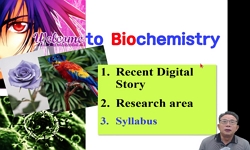The hexameric ATPase p97 has been implicated in diverse cellular processes through interactions with many different adaptor proteins at its N-terminal domain. Among these, the Ufd1-Npl4 heterodimer is a major adaptor, and the p97-Ufd1-Npl4 complex pla...
http://chineseinput.net/에서 pinyin(병음)방식으로 중국어를 변환할 수 있습니다.
변환된 중국어를 복사하여 사용하시면 됩니다.
- 中文 을 입력하시려면 zhongwen을 입력하시고 space를누르시면됩니다.
- 北京 을 입력하시려면 beijing을 입력하시고 space를 누르시면 됩니다.
VCP-Ufd1 결합 및 소포체 연관 분해를 조절하는 Ufd1 인산화에 관한 연구 = A study on the Ufd1 phosphorylation in the regulation of its binding to VCP and ER-associated degradation
한글로보기https://www.riss.kr/link?id=T15349503
- 저자
-
발행사항
수원 : 아주대학교 대학원, 2019
- 학위논문사항
-
발행연도
2019
-
작성언어
한국어
-
주제어
Ufd1 ; VCP/p97 ; PKA ; phosphorylation ; ERAD
-
발행국(도시)
경기도
-
형태사항
38 ; 26 cm
-
일반주기명
지도교수: Lee Sang Yoon
-
UCI식별코드
I804:41038-000000029328
- 소장기관
-
0
상세조회 -
0
다운로드
부가정보
다국어 초록 (Multilingual Abstract)
The hexameric ATPase p97 has been implicated in diverse cellular processes through interactions with many different adaptor proteins at its N-terminal domain. Among these, the Ufd1-Npl4 heterodimer is a major adaptor, and the p97-Ufd1-Npl4 complex plays an essential role in endoplasmic reticulum-associated degradation (ERAD), acting as a segregase that translocates the ubiquitinated client protein from the ER membrane into the cytosol for proteasomal degradation. The Nc lobe of the p97 N domain binds specifically to the SHP box motif of Ufd1. The binding interface between the p97 N domain and the Ufd1 SHP motif has been structurally determined. By using mutations of the binding interface residues in the two proteins, we confirmed their functional implication in ERAD. We further addressed a potential regulation of p97-Ufd1 interaction by Ufd1 phosphorylation based on the conserved phosphorylated residues in the Ufd1SHP. Our results suggest that S229 phosphorylation of Ufd1 may negatively regulate the p97N-Ufd1SHP interaction. We also found that a phosphomimetic mutant (S229D) was less effective in mediating degradation of a misfolded protein tyrosinase-C89R, resulting in accumulation of the ERAD substrate. This implies that S229 phosphorylation of Ufd1 may modulate ERAD by impeding p97-Ufd1 interaction. We are currently working on the identification of a relevant protein kinase responsible for the S229 phosphorylation.
목차 (Table of Contents)
- I. INTRODUCTION 1
- A. VALOSIN-CONTAINING PROTEIN AND ITS ROLE IN THE CELLULAR. 1
- B. ER-ASSOCIATED DEGRADATION AND ROLE OF UFD1 BINDS TO VCP IN ERAD FUNCTION 4
- C. VCP-UFD1 INTERACTION. 8
- D. AIM OF STUDY 10
- I. INTRODUCTION 1
- A. VALOSIN-CONTAINING PROTEIN AND ITS ROLE IN THE CELLULAR. 1
- B. ER-ASSOCIATED DEGRADATION AND ROLE OF UFD1 BINDS TO VCP IN ERAD FUNCTION 4
- C. VCP-UFD1 INTERACTION. 8
- D. AIM OF STUDY 10
- II. MATERIAL AND METHODS 11
- 1. Reagents and Antibody 11
- 2. Cell Culture 11
- 3. Plasmid, siRNA and Transfection 11
- 4. Mutation 12
- 5. Chemical Treatment 12
- 6. Western Blot Analyses 12
- 7. Immonoprecipitation 13
- 8. Immunocytochemistry 13
- 9. GST pull-down assay 13
- 10. ER imaging 14
- 11. The colony formation assay 14
- 12. The colorimetric assay (MTT assay) 14
- 13. Statistical analysis 14
- III. RESULTS 15
- 1. PKA phosphorylates at S229 Ufd1 SHP box. 15
- 2. PKA pathway is stimulated through an agonist of adenylyl cyclase and a Calyculin A phosphatase. 19
- 3. Ufd1 S229 phosphorylation leads to less binding to VCP interaction. 21
- 4. Another serine phosphorylation site in SHP motif is no effect to VCP binding 23
- 5. Other SHP box families DVC1 (S254D), p47 (T254D) and similar effects of phosphomimetic on VCP binding 25
- 6. Functional impairment of ERAD by Ufd1 S229 phosphorylation. 27
- 7. The potential effect of Flag-UFD1 WT and mutation on cell proliferation 30
- IV. DISCUSSION 32
- V. CONCLUSION 35
- REFERENCES 36









